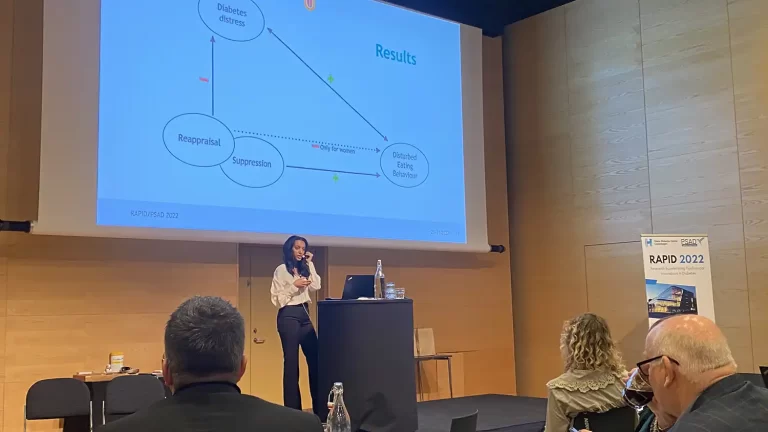By Nicole Walker
This time I want to talk about what other tools we have in the Diabetes Toolkit in order to manage BGLs with exercise. With exercise our BGLs can either rise or fall. In this blog I am predominantly going to be speaking to the majority who experience a fall in BGLs with most exercise. Don’t worry – if you don’t fit into this category YOU ARE NOT ALONE! And I will not leave you out of the advice either but please stay tuned for future blogs!
Exercise that will likely drop your BGLs includes:
Exercise that will likely drop your BGLs includes anything that is slow, steady, more continuous, over a longer period of time that doesn’t get your heart thumping in your chest.
For example, planned exercise that drops our BGL might look like:
- A walk of any length or even a jog or steady run perhaps
- Cycling
- Swimming
Other incidental activity will also drop our BGLs such as:
- Hanging out the washing
- Cleaning the car
- Doing the housework
- Shopping
What about sex?
Sex (like any other exercise – depending on the intensity, duration and whether it is planned or unplanned of course!).
Quick Reminder: BGL targets
Now just a reminder – our BGL target before exercise should start at around 7-10mmol/L (check out our other blog that discusses this further). This is totally individual but when you are unsure, and for the majority, lets go for 7-10 for the sake of this blog. This target also applies for during exercise! We ideally check our BGLs every 30mins during exercise when starting out. So, if we check halfway on our walk, we ideally want to be above 7mmol/L then too!
There are two things we can do to prevent annoying, embarrassing, scary hypoglycaemia with exercise. Both involve making changes to increase our BGL for the period we are exercising and maybe even after exercise also. 1. We can eat carbs. 2. We can reduce insulin.
Exercise Carbohydrates (ExCarbs)
I will be talking about ExCarbs. These are ‘free’ carbohydrates that we eat specifically because we are going to be exercising and we do not need to take insulin for these.
1 ExCarb = 15g Carbohydrates = Approx. 3-4mmol/L rise in BGL
Before exercise we can rise our BGL by 3-4mmol/L with 1 ExCarb portion. This is super handy to know because sometimes exercise is unplanned, or even with the best planning you could be lower than ideal so you can choose to rise your BGL to a level that you are happy to start exercise at. Eg: If your BGL is 5mmol/L 30mins before you go walking, eat 1 x ExCarb portion to get your BGL up to 8-9mmol/L – a safe number for exercise.
We may also need to take ExCarbs with us on our walk. For example, you go for a 60min walk – we should check our BGLs halfway. If our BGL is below 7mmol/L take an ExCarb portion to raise our BGL to bring it back above 7mmol/L, because also you need to walk back home! You don’t need to wait until it comes back up but as long as you know it will rise.
We can use fast acting ExCarbs or slow acting ExCarbs depending on when we need them. If you need your BGL up in a hurry – perhaps you check really close to exercise and your friend is already waiting or the game is about to start, then we can use the fast acting ExCarbs that will rise our BGLs within 15 minutes. Sound familiar? Yes, I am talking about the same 15g carb portions that we would use to treat a hypo.
Fast acting ExCarbs examples:
- 2 x snakes lollies
- 5 x Mentos or Dextro/glucotabs
- 5-7 Jellybeans
- 150mL juice, soft drink, sugar-containing sports drink
- Half a sports gel
If we have more time, say you check your BGL 30 minutes before exercise and it is 5 or 6mmol/L then it is better to take something that is slower release because it will cause your BGLs to stay steady over a longer period. These are also ideal because they contain nutrients and can be incorporated into your day of food as a snack.
Slow acting ExCarbs examples:
- A small muesli bar
- Dried or fresh fruit eg: 6-7 dried Apricots, 1 small banana
- A piece of toast with vegemite or peanut butter
- A fruit yoghurt
- 5 x Jatz crackers
So, you are all set for exercise with a BGL of >7mmol/L, great! Don’t forget to take one or more ExCarbs with you in case your BGL drops below 7mmol/L as you go! Once again think about what type of carbs would be best – and it’s likely to be a mixture.
- Hypo treatment: keep this separate from your ExCarbs so you always have it if you need it. Here’s a reminder on how to treat it
- Fast Acting carbs: if your BGL is <7mmol/L during exercise but is dropping fast and you want to keep exercising. If you are moving at a higher intensity, these are easier to digest also.
- Slow Acting carbs: If your BGL is dropping but not below 7mmol/L, if you are eating for fuelling the exercise eg: a long bike ride or hike that you need to eat for anyway.
Reducing Insulin for Exercise
Ok so a lot of people say to me the thing they hate the most about having diabetes and exercising is the pointless feeling that they need to eat in order to exercise – especially if they are keen to lose weight! I get how frustrating this must be! And thankfully there is another solution, reducing your insulin.
Let’s think – how does this work? Well in an “ideal” world where we are carb counting and matching our insulin to our carbs perfectly our BGLs will stay in a tight 4-8mmol/L range most of the time (yeah…right!). If we exercise, we end up disrupting this theoretical perfect harmony and our BGLs go too low. However, what if we took less insulin? If we took less insulin at a meal then our BGLs will be higher for the next 3-4 hours until we correct it later. If we want to prevent low BGLs during exercise we can “hover” our BGLs higher to counteract the effects of exercise and balance out the two effects. Great!
How can I reduce my insulin?
You have two insulins:
- MEAL insulin you take to cover your food and as a correction (you might call this BOLUS insulin on a pump)
- BACKGROUND insulin you have running all the time (you call this BASAL insulin on a pump)
The most important thing for reducing insulin for exercise is being able to plan. If the exercise is planned then you will know a few hours before what you can do with your insulin. If it is spontaneous then we can’t easily reduce insulin for exercise. Here is why and here is how we do it:
MEAL insulin
Our meal insulin is working at it’s hardest at 2 hrs. Therefore, if you are exercising within 2hrs of taking meal insulin we can reduce the insulin at the meal before exercise by 20-50% to hover our BGLs higher for that exercise. This advice can apply to both people on injections and those on pumps.
For example: You want to go for a morning walk with a friend. You could have breakfast at 7am and need 6 units for this. Take 50% off your usual dose of insulin because you are exercising and only take 3 units instead. Go walking at 8-9am. If you need a correction and your total insulin would be 10 units (6 units for food and 4 units for a correction) take of 50% and take 5 units. This still means you are able to take a bit of a correction BUT you are also allowing for the exercise.
Using a percentage is more helpful than just taking off 1-2 units.
Using a percentage is more helpful than just taking 1-2 units off. Say for example the next day you decide to have a bigger breakfast and need 10u for the food. Well you can still take 50% off your dose. Taking it off by 1-2 units isn’t always consistent because it doesn’t allow for a correction or changes to our insulin requirements for food. The more we take, the more insulin is in our system, the greater risk of hypoglycaemia therefore it is best to take a relative reduction using a %.
Rule of thumb, start reducing by 50% and work your way back if that is too much to 30% or 25% or 20% reductions. Eg: if you need 10u take 5u the first time you try. If that is too much then try taking off 2-3 units the next time. This is safer as it will just run you a bit higher in those trials and at least it prevents a hypo!
How do you know if you have reduced it too much?
Easy, your BGLs will be annoyingly high during and straight after exercise. You might need more of a reduction at the start of a new exercise like 50% or even a 75% reduction but as you get fitter maybe you only need a 20% reduction. Also, for different exercises you might need different % changes swimming vs cycling. Write it down – keep an exercise diary to figure out and remember what works for you!
BACKGROUND/BASAL Insulin
This advice is different for those on injections to pumps as on a pump we can tweak our background insulin for two hours ahead, affecting the BGLs within 2hrs time. But on injections we take one or two injections a day which means those changes will affect BGLs for the next 12-24hrs.
For Pumpers
You can put on a temporary basal rate 1.5 – 2hrs before exercise which means by the time you start exercising you have less active insulin in your body and your BGLs should be running a bit higher by now. This timing is individual and it’s best to work out the ideal time for you! Keep the basal rate running at a reduced rate during exercise and perhaps for several hours afterwards. Keep it for 2-4hrs afterwards for light – moderate exercise. But for up to 12 hours or longer if heavy exercise, if the exercise is new to you or if you went for a long duration.
As for how much? If you are putting on temp basal rates alone as a strategy you can reduce by 20-80%. For example: You decide to reduce your basal by 30%. Your basal rate usually runs at 100% so to reduce by 30% you want to run at 70% of your normal basal. Go to your temp basal feature in your pump and set a temp basal for 70% for the desired time period. If you are reducing meal time insulin as well or eating ExCarbs too then reduce by 20-50% as a starting point.
For Injections
Only reduce your Background insulin dose eg: Toujeo, Lantus, Levemir if you are exercising for a very long time eg: > 4hrs. You might be thinking “well I never run that long!”. Firstly that is a great effort if you do! However exercise is just activity remember so things like; moving house, a day of spring cleaning or gardening or shopping for Christmas presents, a day exploring a new town, a day at the beach with kids will all probably count! If you take two doses of background insulin you have the most flexibility with this, or if you take your insulin in the morning. In these two options you can reduce your insulin before this long exercise by 10-20% as a starting point.
If you take background insulin at night only – it is probably not a good idea to reduce it then, otherwise you will just run uncomfortably high all night and might wake up feeling too rubbish to exercise anyway! If this is the case then you should take advantage of the other strategies shared above.
Whatever you do – keep taking your insulin! Don’t ever skip the dose completely unless it is ExCarbs you are eating or unless you are doing exercise for a short time (one hour or less) and cannot wear your pump eg: contact sports or swimming.
Remember, exercise itself is variable!
Remember, exercise itself is so variable and we are all individual human bodies that will respond differently. There is no one-size-fits all between people with diabetes. And there is not even a one-size-fits all for one person, there are many day to day factors that will affect your best plan. It is good to read up on what you can do, pick a starting point and just try and try again! But the most important thing – don’t be too hard on yourself because perfection doesn’t exist. Your BGLs will get more stable over time with practice and when you start to get fitter! Just keep safe, keep exercising and enjoy! Here are some cool groups to get you motivated: Typeonerun, Beat–It and JDRF walk. Get in touch with YOUR Dietitian, Sports Dietitian, Diabetes Educator, Endocrinologist or Exercise Physiologist if you need more help getting started.



